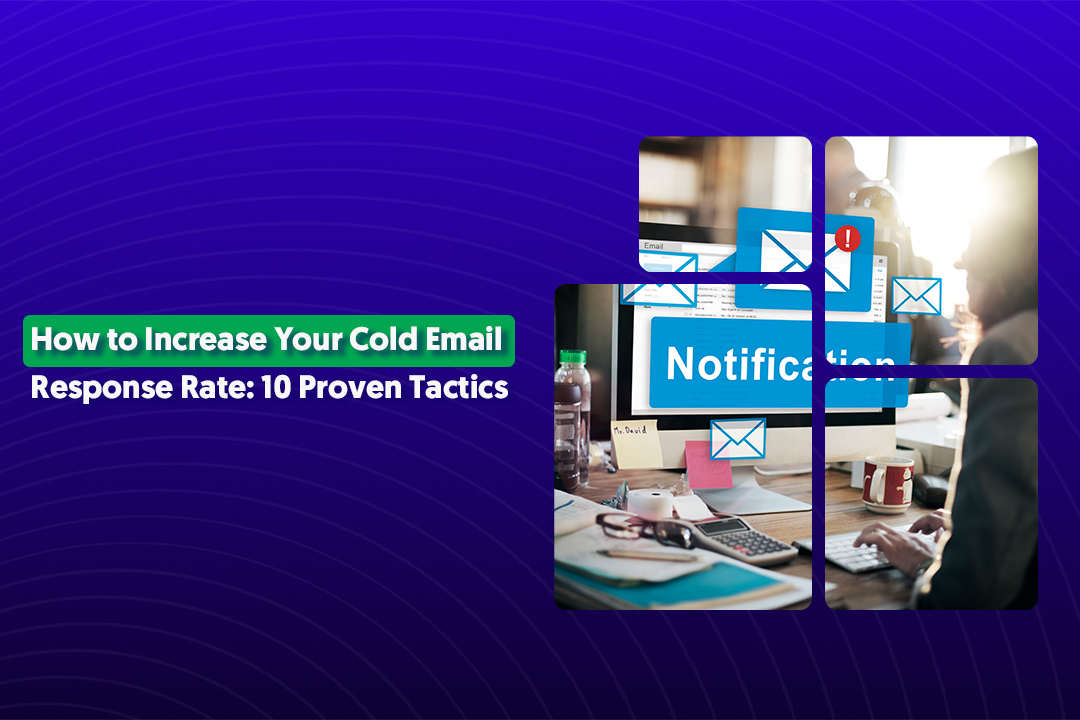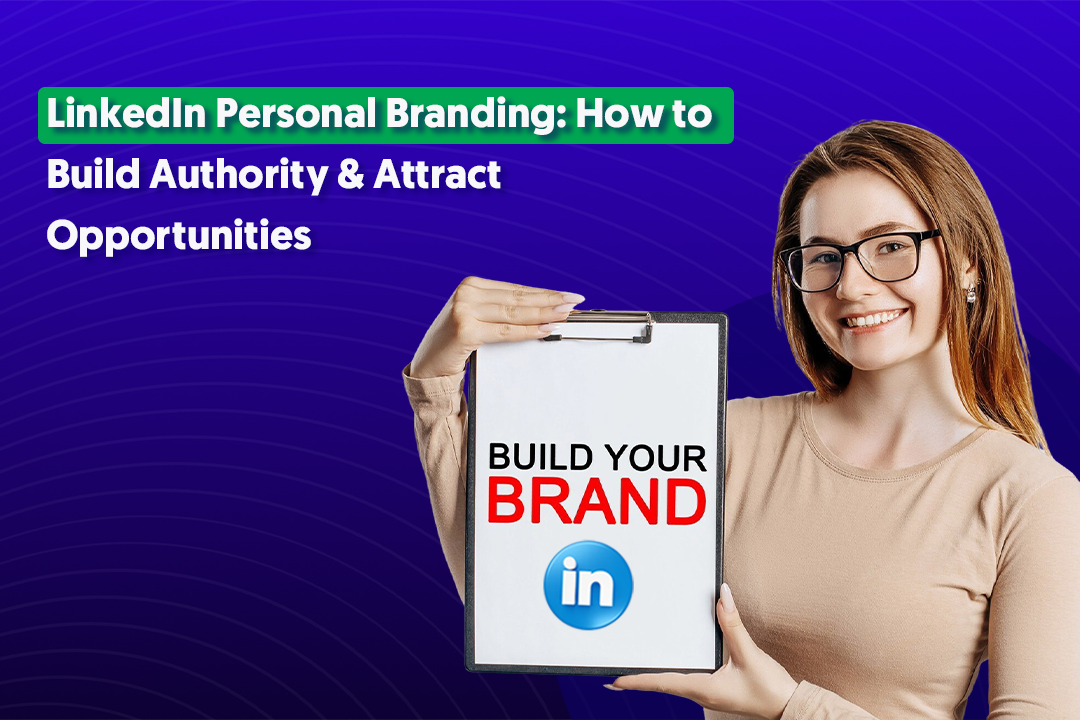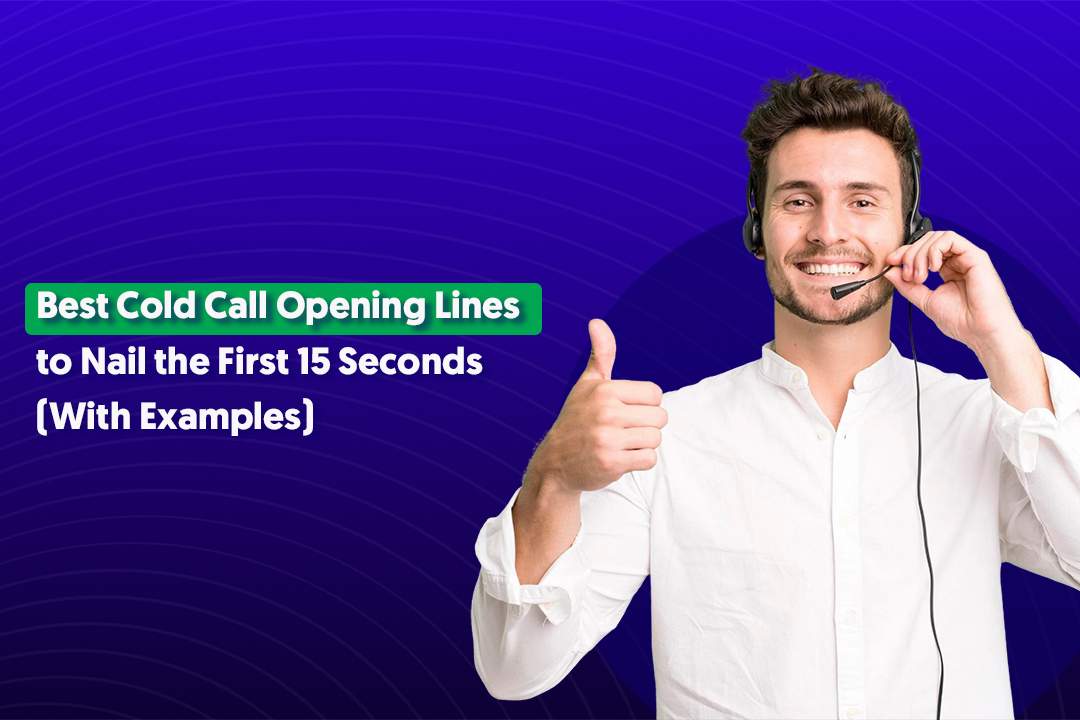Table of Content
Key Takeaways
- B2b cold email works because it gives you direct access to decision-makers at a predictable cost.
- Personalize the first line deeply—generic emails get ignored, specific research gets replies.
- Keep emails 60-100 words max with soft CTAs that lower the barrier to respond.
- 70% of replies come from follow-ups—send 4-6 per sequence with different angles each time.
- Deliverability beats copy—fix your technical setup (SPF, DKIM, warm-up) before obsessing over words.
- Track reply rates and meetings booked, not vanity metrics like open rates.
- Short subject lines (2-5 words) outperform long ones every time.
B2B cold email is still one of the most scalable ways to land clients without burning through your ad budget or waiting months for SEO to kick in.
But here's the thing: most B2Bcold emails fail. Hard.
We're talking about generic "just checking in" messages, bought lists with zero accuracy, and subject lines that scream "delete me."
The result? Inbox silence. Zero meetings. And frustrated sales teams wondering why nothing's working.
But when you get B2B cold email right—with solid targeting, actual personalization, and messaging that doesn't sound like a robot wrote it—it becomes your most predictable client acquisition channel.
We've seen it work for over 10,000 B2B companies, from early-stage startups to teams at Amazon, Google, and Uber.
This guide breaks down exactly what works. You'll get proven b2b cold email tactics, templates you can steal, subject lines that get opened, and the step-by-step process we use to generate millions in pipeline revenue for our clients.
This is for you if you're:
- A B2B founder tired of inconsistent lead flow.
- An SDR or sales leader trying to hit quota without guessing.
- Running an agency or consultancy that needs predictable outreach.
- On a SaaS team looking to scale without blowing up your CAC
Let's dive in.

Why Cold Email Works for B2B Client Acquisition
Here's why b2b cold email tactics still outperform most other channels when you're trying to land enterprise clients or fill your pipeline consistently.
You get direct access to decision-makers
No algorithm deciding who sees your message. No ad spend required to reach a VP or founder. Just you, your offer, and their inbox. When you nail your targeting, you're talking directly to the person who signs contracts—not someone three levels removed from the buying decision.
You control the targeting and can scale the volume.
Unlike paid ads where you're guessing at intent signals, b2b cold email tactics let you handpick exactly who you want to work with. Need to reach 500 CMOs at Series B SaaS companies? Done. Want to target IT directors at healthcare orgs with 200+ employees? Easy. And once your messaging works, you can scale from 50 emails a day to 500 without changing your entire strategy.
Check This Out: Best Cold Email Blueprint to Generate Leads (100% Tested)
It works across pretty much every B2B industry.
We've run successful campaigns for:
- SaaS companies selling to enterprises
- IT service providers targeting mid-market firms
- Consulting firms going after Fortune 500s
- Lead gen for Marketing agencies
- Lead gen for Financial services
The fundamentals stay the same—you just adjust your targeting and messaging.
Cold email beats other channels on predictability and cost.
Here's the reality:
- Paid ads require constant budget, and your CAC can spike overnight if competition increases.
- SEO takes 6-12 months to gain traction, and you're dependent on Google's algorithm.
- LinkedIn outreach hits connection limits and gets expensive fast with InMail credits.
- Cold calling is time-intensive and hard to scale without a massive team
B2B cold email tactics give you measurable conversions at a fraction of the cost. You know exactly how many emails went out, how many opened, how many replied, and how many turned into meetings.
That predictability means you can forecast pipeline, plan hiring, and actually hit revenue targets without crossing your fingers.
When we help clients dial in their cold email strategy, they're not just getting leads—they're building a repeatable system that generates a consistent pipeline every single month.
What You Need Before You Start Your B2B Cold Email Campaign
Most B2B cold email best practices get ignored because people want to jump straight to sending.
But if you skip the setup, your emails either land in spam or get ignored. Here's what you actually need before hitting send.
Get crystal clear on your ICP. You can't write a compelling email if you don't know who you're talking to. Nail down:
- Industry and company size (revenue, employee count)
- Job titles and roles (not just "marketing" — are you targeting CMOs, demand gen managers, or growth leads?)
- Geography and market segments
- Specific pain points they're dealing with right now
The tighter your ICP, the better your messaging. Generic emails to "anyone in SaaS" don't work. Emails to "VPs of Sales at Series B fintech companies struggling with outbound" do.
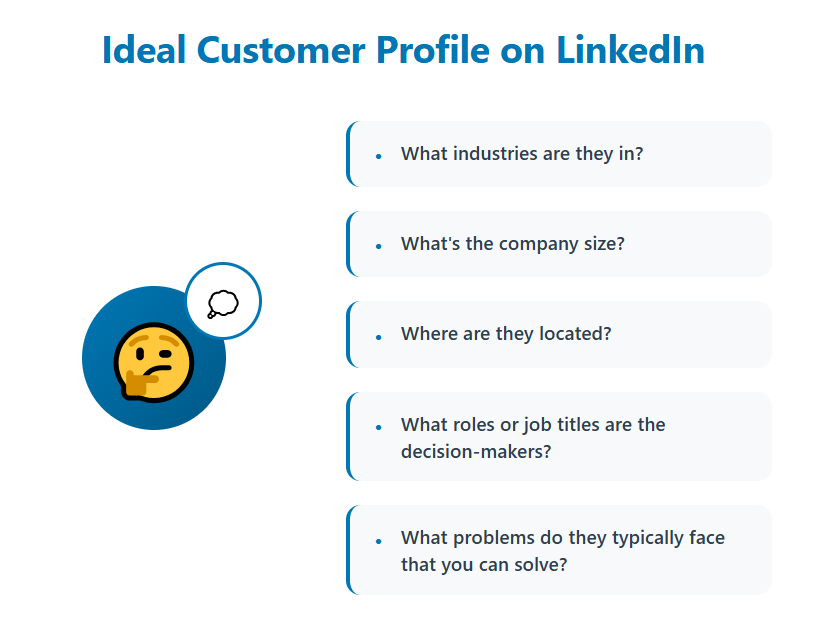
Clarify your offer and value prop. What problem are you solving, and why should they care? If you can't explain your value in one sentence, your prospects definitely won't get it. This isn't about features—it's about outcomes. "We help X achieve Y without Z" is the formula that works.
Start with quality data, not quantity. Buying a list of 50,000 emails sounds great until you realize 40% bounce and the rest are outdated.
Following B2B cold email best practices means:
- Using verified contact databases (Apollo, ZoomInfo, Seamless, etc.)
- Running emails through email verification tools before sending (NeverBounce, ZeroBounce)
- Checking LinkedIn to confirm the person's still at the company
Bad data kills campaigns before they start.
Learn More About: Data Enrichment & Why It’s Crucial for Better B2B Outreach
Set up your email infrastructure correctly. This is non-negotiable if you want to land in inboxes:
- SPF, DKIM, and DMARC records must be configured on your domain.
- Use a dedicated sending domain (like outreach.yourcompany.com) to protect your main domain.
- Set up multiple email accounts if you're scaling volume—don't send 500 emails from one address.
Warm up your email accounts. Brand new domains and email addresses scream "spam" to inbox providers.
Email Warm-up tools gradually increase your sending volume over 2-4 weeks to build sender reputation. Skip this step and you're going straight to spam folders.
Choose your outreach angle. One of the most overlooked b2b cold email best practices is having a clear angle before you write. Pick one:
- Pain-focused: "We noticed you're probably dealing with X problem..."
- Opportunity-based: "Companies like yours are seeing Y results by doing Z..."
- Insight-driven: "We analyzed your [website/strategy/competitors] and found..."
- Audit/value-first: "We put together a quick analysis of how you stack up..."
Your angle shapes your entire message. Nail this upfront and the rest writes itself.
Get these foundations right, and your campaigns actually have a shot at working. Skip them, and you're just adding to inbox noise.
Anatomy of a High-Converting B2B Cold Email
A good cold email template b2b isn't about clever copy or fancy formatting. It's about structure. Here's what actually gets replies.
The Winning Structure:
1. Personalized opening line (1 sentence) Reference something specific about them—recent hire, company news, a post they shared, or a clear pain point their role deals with. This proves you didn't copy-paste to 10,000 people.
2. Problem recognition (1-2 sentences) Show you understand the challenge they're facing right now. Don't guess—tie it to their industry, role, or company stage. If they don't feel the problem, they won't care about your solution.
3. Value-driven statement (1 sentence) What you do and the outcome it drives. Skip the features. "We help [their role] [achieve specific result] without [common pain point]" works every time.
4. Short social proof (optional, 1 sentence) If you've worked with similar companies or have a relevant win, drop it here. "We've done this for [recognizable company/industry]" adds credibility without bragging. If you don't have it yet, skip it—don't force it.
5. Soft CTA (1 sentence) No "let's hop on a call" pressure. Ask if it makes sense to explore, if they're open to chatting, or if you should send over more info. The goal is a reply, not a hard close.
Keep it short. The best cold email template b2b formats are 60-100 words max. If your email requires scrolling on mobile, it's too long. Cut the fluff. Every sentence should either build relevance or move toward the CTA.
Write for skimmability. Decision-makers skim emails in 3-5 seconds. Use:
- Short sentences (10-15 words max)
- Line breaks between ideas
- No walls of text
If they can't grasp your point in one quick scan, you've already lost them.
This structure works because it respects their time, shows you did your homework, and makes it easy to say yes to a conversation. That's what converts.
B2B Cold Email Examples & Templates That Actually Get Clients
Here's the thing about b2b cold email examples: templates give you structure, but personalization is what gets replies.
Use these as frameworks, not copy-paste scripts. Swap in real details about your prospect, their company, and their situation—that's what separates a 2% reply rate from a 20% one.
We've grouped these b2b cold email examples by use case so you can pick what fits your situation.
Template 1 — Short & Direct B2B Cold Email
When to use: You have a clear value prop and a well-defined ICP.
Subject: Quick question, [First Name]
Body
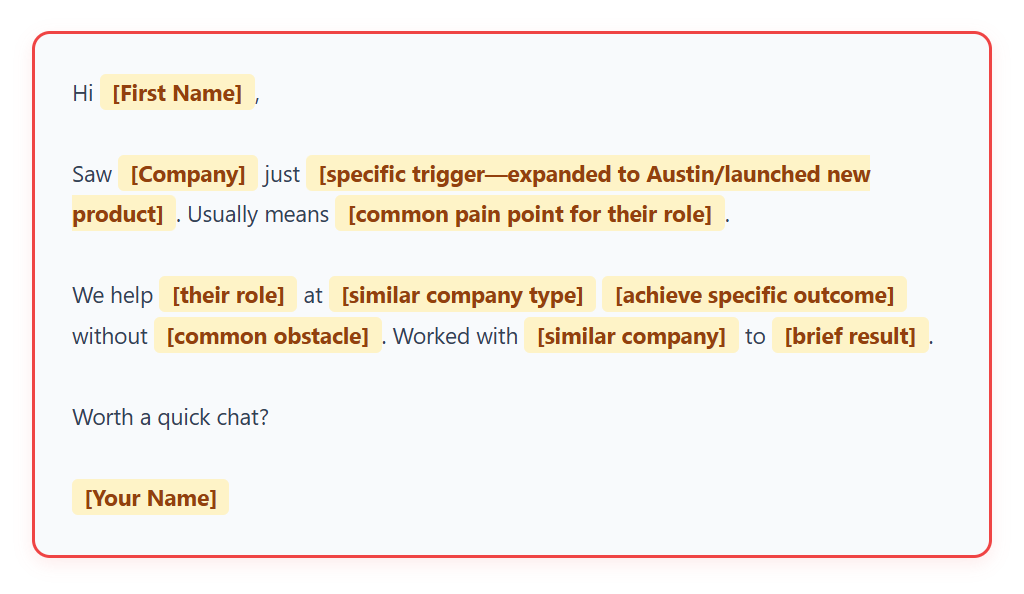
Template 2 — Value-First "Free Insight/Audit" Email
When to use: You can deliver something valuable upfront without a call.
Subject: Put together something for [Company]
Body:

Template 3 — Case-Study Email With Results
When to use: You have strong proof and want to lead with credibility.
Subject: How [Similar Company] hit [specific result]
Body:

Template 4 — LinkedIn-Based Personalization Email
When to use: They posted something relevant or you have a genuine connection point.
Subject: Loved your post on [topic]
Body:

Template 5 — Trigger-Based Email (Funding, Hiring, Launch)
When to use: They hit a milestone that signals they need what you offer.
Subject: Congrats on the Series B
Body:
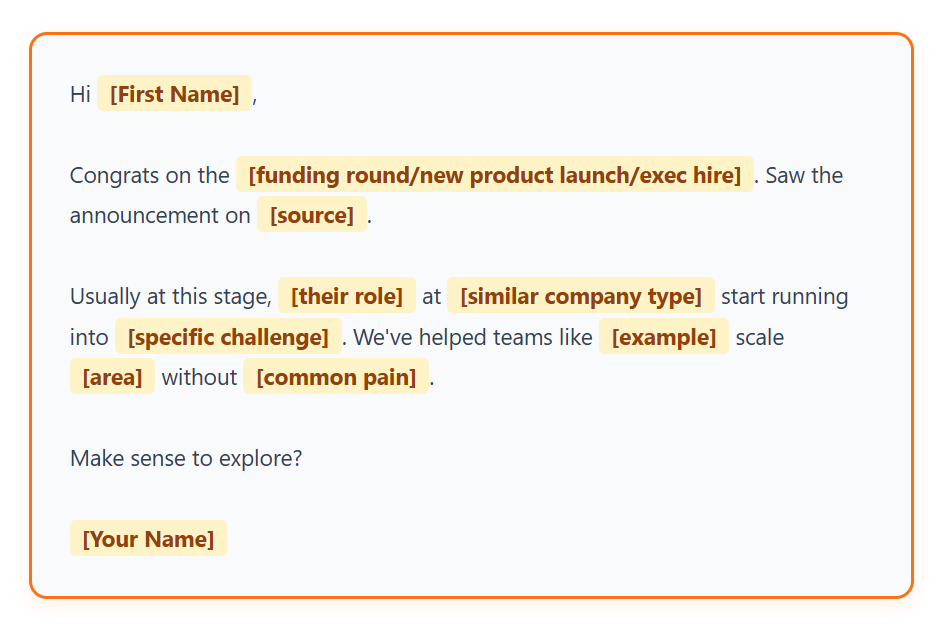
Template 6 — Social Proof Email ("We help companies like yours")
When to use: You have recognizable clients in their space.
Subject: Re: [their company type] outreach
Body:

Template 7 — Competitor Positioning Email
When to use: You know they're using a competitor or alternative solution.
Subject: [Competitor] vs. what we're doing
Body:
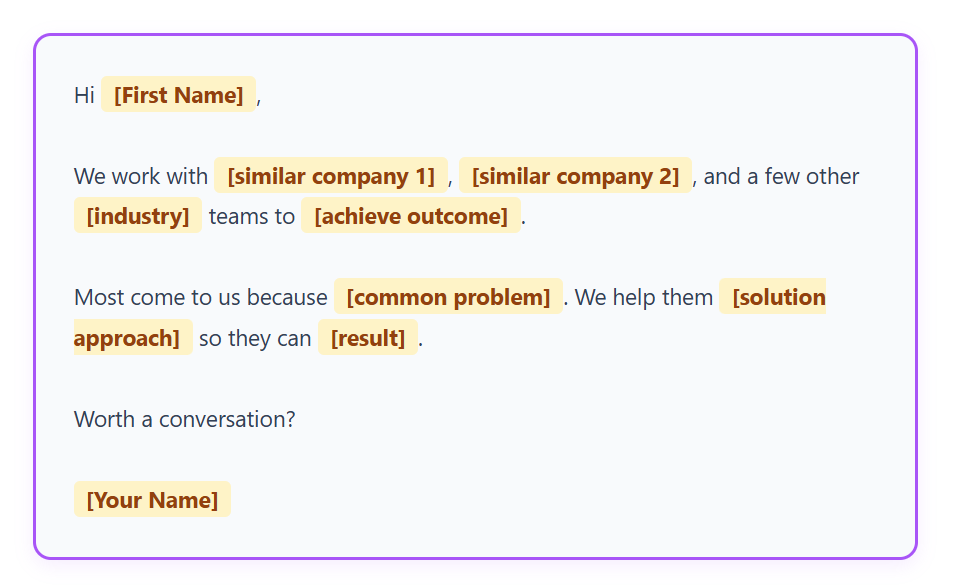
Template 8 — Founder-to-Founder Email
When to use: You're a founder reaching out to another founder.
Subject: Fellow founder—quick question
Body:

Template 9 — "Made Something for You" Custom Loom/Breakdown
When to use: You've invested time creating something personalized (Loom, audit, teardown).
Subject: Made this for you
Body:

Template 10 — Follow-Up Email (After No Response)
When to use: First email got no reply. This is your second touch.
Subject: Re: [original subject]
Body:
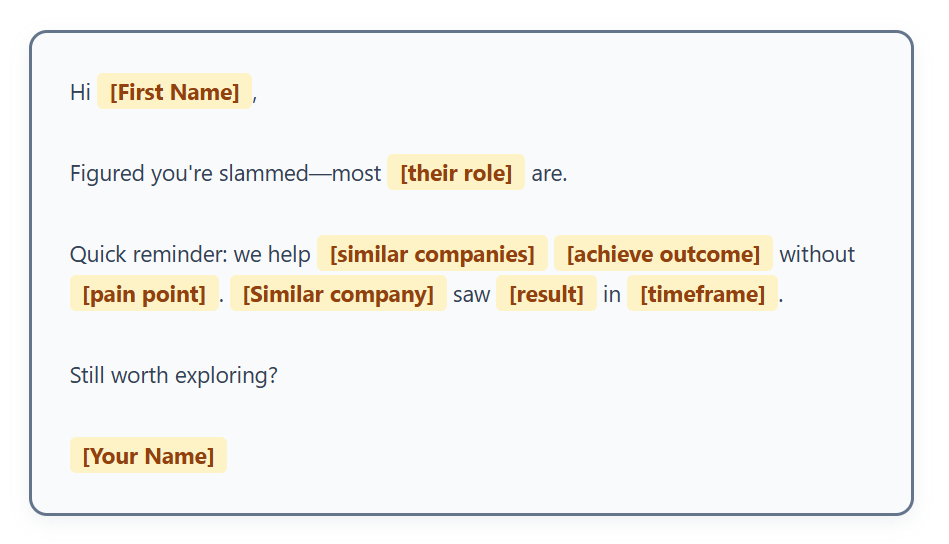
These b2b cold email examples work because they're short, specific, and built around real scenarios. Pick the one that matches your situation, personalize the hell out of it, and test. That's how you go from templates to actual clients.
Best B2B Cold Email Subject Lines That Boost Open Rates
Your b2b cold email subject lines matter more than you think. The best email in the world doesn't work if it never gets opened.
Short wins. Every time. Keep your b2b cold email subject lines between 2-5 words.
Anything longer gets cut off on mobile, and decision-makers don't have patience for essay-length subjects. Short feels personal. Long feels like marketing.
Here's what works, broken down by category:
Curiosity-Based Subject Lines
These make them wonder what you're talking about—without being clickbait.
- Quick question, [First Name]
- Thought about [Company]
- Noticed something
- [Their Company] + [Your Company]
- Idea for you
- Quick thought
Direct and Relevant Subject Lines
No games. Just tell them why you're reaching out.
- Re: [specific pain point]
- [Competitor] vs. us
- Helping [similar company type]
- [Their role] at [Company]
- About [specific project/initiative]
- [Industry] outreach
Personalized/Trigger-Based Subject Lines
Reference something real and timely about them or their company.
- Congrats on [funding/launch/hire]
- Saw your post on [topic]
- [Mutual connection] recommended I reach out
- Following up from [event]
- Your [recent company news]
- [First Name]—[specific observation]
Value-First Subject Lines
Lead with what's in it for them.
- Made this for [Company]
- Free audit: [Company]
- [Specific insight] for [First Name]
- Breakdown I put together
- Quick win for [their role]
The Permission Pattern
Disarms skepticism by asking first.
- Permission to share an idea?
- Okay to send this over?
- Worth a look?
What NOT to do:
- All caps (screams spam)
- Excessive punctuation (!!!)
- "Free," "Limited time," or other trigger words
- Generic lines like "You'll want to see this"
- Anything that sounds like a marketing blast
The best b2b cold email subject lines feel like they're from a real person, not a campaign. Test a few from each category, track your open rates, and double down on what works for your audience.
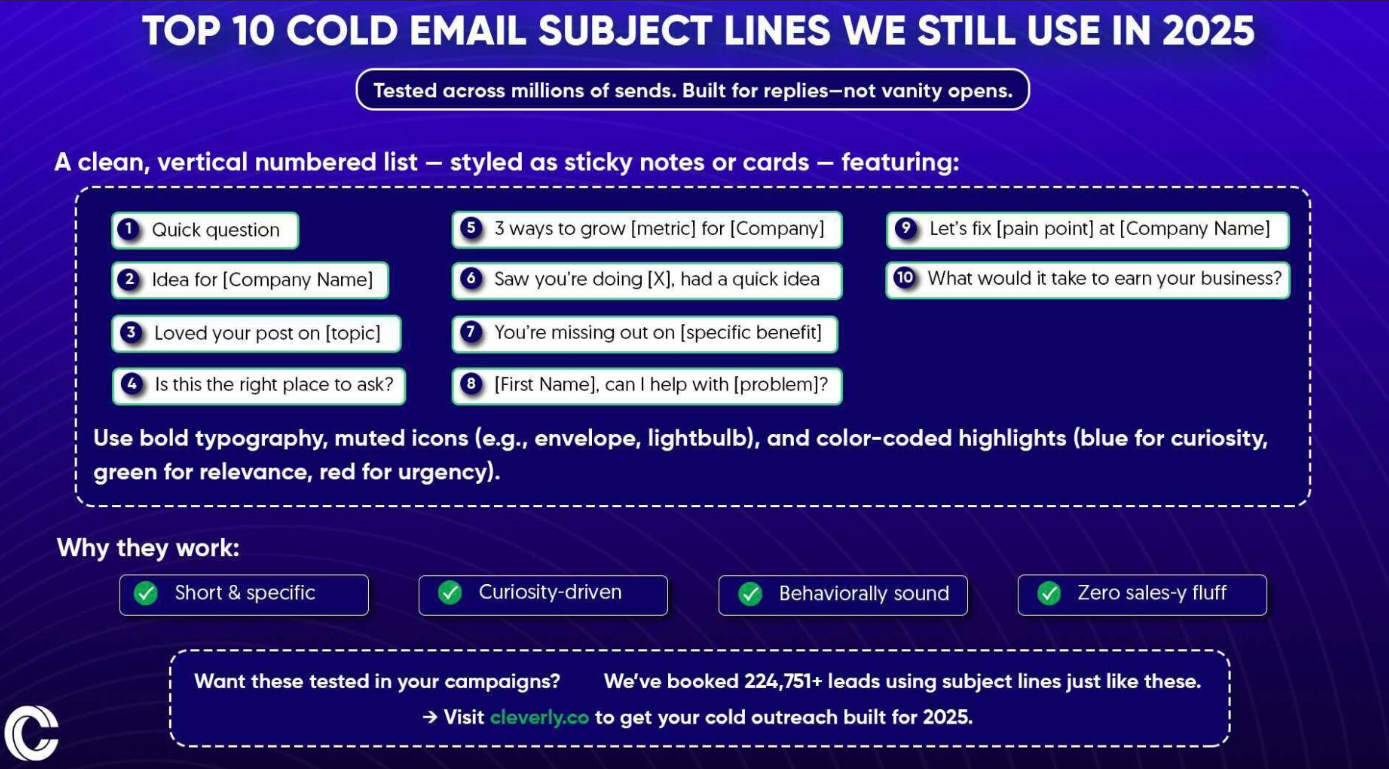
Proven B2B Cold Email Tactics to Increase Replies
Getting opens is one thing. Getting replies is where most b2b cold email tactics fall apart. Here's what actually moves the needle.
Lead with insights, not introductions.
Nobody cares that you're the VP of Sales at XYZ Corp. They care about what you noticed, what you can help with, or what's relevant to them right now.
Skip "My name is..." and start with "Noticed [Company] just expanded into Texas" or "Most [their role] we talk to are dealing with [problem]." Get to the point immediately.
Personalize the first line like you mean it.
This is the most important of all b2b cold email tactics. Reference something specific—a LinkedIn post, recent company news, a mutual connection, or a clear pain point tied to their role or industry. Generic personalization like "I saw you work in marketing" doesn't count. Go deeper. Show you did 30 seconds of research.
Write like you're texting a colleague.
Ditch the corporate speak. No "I hope this email finds you well" or "I wanted to reach out to discuss synergies." Write the way you'd actually talk. Short sentences. Natural language. If it sounds stiff when you read it out loud, rewrite it.
How to Write Cold Emails That Get Replies (Complete Guide)
Avoid attachments and walls of text.
Attachments trigger spam filters and make people suspicious. Links to case studies or one-pagers are fine—attachments aren't. Same goes for formatting. No long paragraphs. Break up every 1-2 sentences. Make it skimmable on mobile in under 5 seconds.
Use soft CTAs that don't pressure.
Hard closes like "Let's schedule a call for Tuesday at 2pm" kill reply rates. Instead, try:
- "Worth exploring?"
- "Make sense to chat?"
- "Curious if you're running into this?"
- "Want me to send over more info?"
You're asking for a conversation, not a commitment. Lower the barrier to reply.
Timing matters more than you think.
Best time to send cold emails:
- Tuesday–Thursday, 8-10am or 1-3pm (local time to recipient)
- Avoid Mondays (inbox overload) and Fridays (people check out early)
- For executives, early mornings (6-8am) can work—they're triaging before meetings start
Test your audience, but these windows consistently perform best.
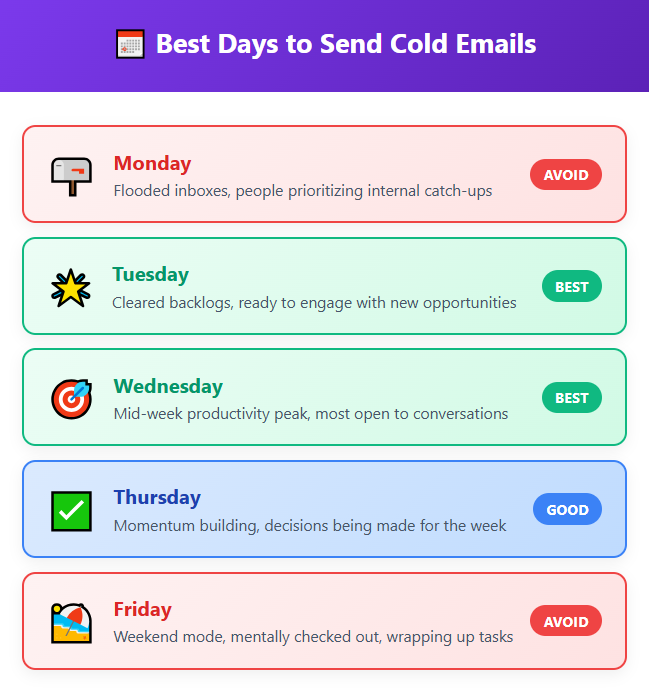
Drop a PS line for extra personalization.
A PS is the second-most-read part of an email after the subject line. Use it to add another personalized touch or reinforce relevance:
- "PS—Saw you're hiring SDRs. Timing might be perfect for this."
- "PS—Loved your take on [topic] in that recent post."
- "PS—We just helped [similar company] with this exact issue."
It feels conversational and gives them another reason to reply.
The biggest mistake? Trying to close a deal in the first email. Your only job is to start a conversation. Nail these b2b cold email tactics, and replies follow naturally.
Follow-Up Strategy: Where Most B2B Deals Are Won
Here's a stat that changes everything: 70% of replies come after follow-ups. Yet most people send one email and give up. That's where deals die.
One of the most underrated b2b cold email best practices is having a real follow-up strategy—not just "bumping this up" three days later.
Send 4-6 follow-ups per sequence.
Your first email rarely catches someone at the right moment. They're in meetings, traveling, dealing with fires, or just didn't see it. A proper sequence looks like this:
- Email 1: Initial outreach
- Email 2: 3-4 days later
- Email 3: 3-4 days after that
- Email 4: 5-7 days later
- Email 5: 7 days later
- Email 6: Final breakup email (2 weeks later)
Most replies come between emails 2-4. If you're only sending one or two, you're leaving deals on the table.
Each follow-up should add new value or a different angle.
Don't just say "following up" and resend the same message. That's lazy and annoying. Instead, following b2b cold email best practices means giving them a reason to reply:
Follow-up 1: Share a relevant insight or case study "Hi [Name], wanted to share this quick case study—[Similar Company] had the same challenge and saw [result] in [timeframe]. Think it could apply to [their company]?"
Follow-up 2: Ask a different question or shift the angle "[Name], curious—is [pain point] even on your radar right now, or are you focused elsewhere?"
Follow-up 3: Reference a trigger event or new information "Saw [Company] just [recent news]. Usually means [implication]. Worth discussing how we've helped others navigate this?"
Follow-up 4: Offer something valuable with no ask "No worries if timing's off. Put together this [resource/breakdown/insight] that might help regardless: [link]"
Follow-up 5: The breakup email "[Name], figured now's not the right time. Totally get it. I'll close the loop on my end—feel free to reach out if things change down the road."
Breakup emails get replies. Why? They feel final, which creates urgency. And they're respectful, which people appreciate.
Handle objections and re-engage dead threads.
Sometimes you'll get a soft no: "Not interested right now" or "We're all set." Don't just accept it and move on. Re-engage lost leads 2-3 months later with:
"Hi [Name], we talked back in [month] and timing wasn't right. Since then, we've helped [similar company] with [specific result]. Worth revisiting?"

Formatting matters in follow-ups too.
Keep them even shorter than your initial email—2-3 sentences max. Use the same thread (hit reply, don't start a new email). And don't apologize for following up. You're offering value, not bothering them.
At Cleverly, we've sent millions of follow-ups for clients. The data's clear: most meetings come from emails 3-5 in a sequence. If you're not following up consistently with fresh angles, you're missing where the real conversions happen. That's why this is one of the most critical b2b cold email best practices you can implement.
More to Check: Sample Emails to Approach New Clients (Proven Templates + Tips)
Cold Email Deliverability & Technical Setup (Your Hidden Advantage)
Here's the truth: the best copy in the world doesn't matter if your emails land in spam.
Most people obsess over subject lines and CTAs while ignoring the technical setup that actually determines if their emails get seen.
Fix your email deliverability first, optimize your copy second.

Use dedicated sending domains.
Never send cold emails from your main company domain (like yourname@company.com). If you get flagged as spam or hit high bounce rates, your entire domain reputation tanks—including emails from your CEO, support team, and actual customers.
Instead, set up a dedicated sending domain:
- Buy a domain variation (like reach.company.com or outreach.company.com)
- Configure it properly with SPF, DKIM, and DMARC records
- Use it exclusively for outbound campaigns
This protects your main domain and gives you room to test without risking your core business email.
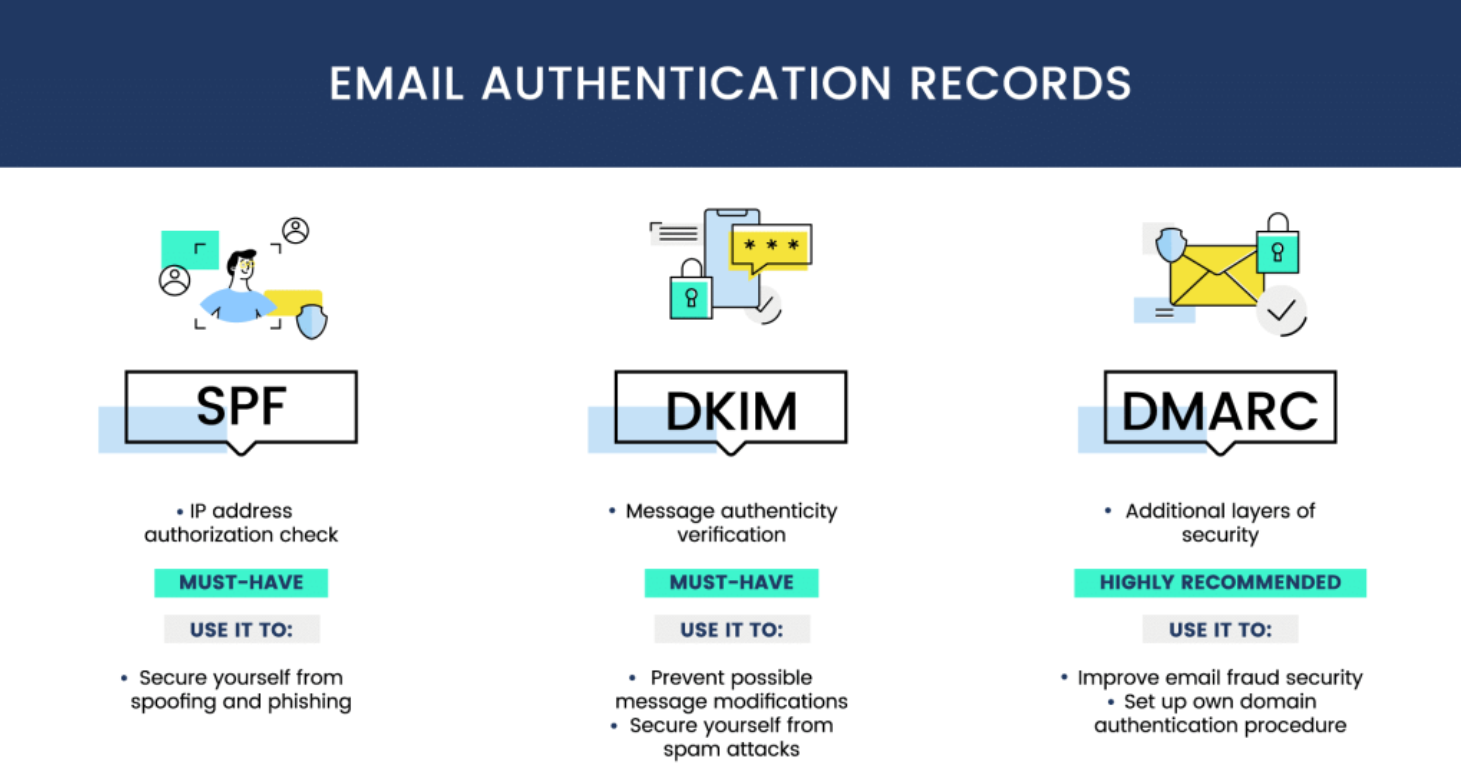
Warm up your email accounts before sending.
Brand new email addresses have zero sender reputation. If you immediately blast 200 emails, you're going straight to spam. Use warm-up tools (Warmbox, Mailreach, Instantly) to:
- Gradually send and receive emails from your new accounts
- Build positive engagement signals (opens, replies, moves to inbox)
- Ramp up volume over 2-4 weeks before launching campaigns
Skip this step and your deliverability is cooked from day one.
Avoid spam triggers like your reputation depends on it (because it does).
Inbox providers scan for patterns that scream "mass email." Here's what kills deliverability:
- Spammy words: "free," "guarantee," "limited time," "act now," "click here"
- ALL CAPS or excessive punctuation (!!!)
- Too many links (stick to 1-2 max)
- Images and attachments in cold emails
- Sending the exact same email to hundreds of people (use spinning/variation)
Text-only emails with minimal links perform best. Period.

Manage your bounce rate religiously.
High bounce rates (over 5%) destroy your sender reputation fast. This happens when you're emailing invalid addresses, role-based emails (info@, sales@), or outdated contacts.
To keep bounce rates low:
- Verify emails before sending (NeverBounce, ZeroBounce, Clearout)
- Remove bounces immediately from your lists
- Don't buy third-party lists—they're full of dead emails
One bad list can ruin months of warm-up work.
Stick to text-only formatting.
Fancy HTML templates, branded signatures with images, and embedded graphics all hurt deliverability. Why? They look like marketing emails, not personal messages. Keep it simple:
- Plain text only
- No HTML formatting
- Minimal signature (name, title, one link max—no logos or images)
- Standard fonts (no custom styling)
Your emails should look like they came from a real person typing in Gmail or Outlook. Anything else gets filtered.
Send volume matters too.
Don't go from 0 to 500 emails overnight. Gradually scale:
- Week 1-2: 20-50 emails/day per account
- Week 3-4: 50-100 emails/day
- Week 5+: 100-150 emails/day (max)
Use multiple email accounts if you need higher volume. Spreading sends across 3-5 accounts keeps each one under radar.
Monitor your metrics constantly.
Track:
- Bounce rate (keep under 5%)
- Spam complaint rate (keep under 0.1%)
- Open rates (if these tank suddenly, you've got a deliverability issue)
If any metric spikes, pause and diagnose before continuing.
Most people lose at cold email because they never make it to the inbox. Get your technical setup right, and you're already ahead of 80% of your competition. That's your hidden advantage.
Key Metrics to Track in B2B Cold Email Campaigns
You can't improve what you don't measure. Here's what actually matters when you're running b2b cold email campaigns—and what's just noise.
👉 Deliverability Rate (Target: 95%+) This is the percentage of emails that actually get delivered vs. bounced. If your deliverability drops below 95%, you've got a data quality problem or technical setup issue. Fix it immediately before your sender reputation tanks.
👉 Open Rate (Target: 40-60%) Tells you if your subject lines and sender reputation are working. Anything below 40% means either your b2b cold email subject lines aren't compelling, you're landing in spam, or your targeting is off. Above 60%? You're nailing it.
Must Read: How to Increase Your Cold Email Response Rate (10 Proven Tactics)
👉 Reply Rate (Target: 5-15%) This is the only metric that actually matters for pipeline. What percentage of people are responding to your emails? Positive or negative replies both count here—you want engagement. Under 5% means your messaging isn't resonating. Over 15%? You've hit product-market fit with your outreach.
👉 Positive Reply Rate (Target: 3-10%) Replies that show genuine interest—questions, requests for more info, or "yes, let's chat." This directly correlates to meetings booked. If your overall reply rate is high but positive replies are low, you're getting "not interested" responses, which means targeting or messaging needs work.
👉 Meeting Booked Rate (Target: 2-5%) The percentage of people you email who actually book a meeting. This is where rubber meets road. Everything else is a vanity metric if this number's low. At Cleverly, this is what we optimize for—because meetings turn into deals.
👉 Bounce Rate (Target: Under 5%) Hard bounces (invalid emails) kill your sender reputation. If you're above 5%, your list quality is terrible. Verify emails before sending and remove bounces immediately.
👉 Unsubscribe/Spam Complaint Rate (Target: Under 0.5%) High unsubscribe or spam rates signal your targeting is off or your emails feel too salesy. Keep this under 0.5% to protect deliverability. If it spikes, pause and rework your messaging.
👉 Response Time How quickly prospects reply after you send. Most responses come within 24-48 hours. If you're getting replies but they're slow, follow-ups might be saving your campaigns. Fast responses mean your message hit at the right time with the right person.
👉 Email-to-Meeting Conversion Rate How many emails does it take to book one meeting? If you're sending 500 emails to book 10 meetings, that's a 2% conversion rate. Track this so you can forecast pipeline and know exactly how much volume you need to hit your targets.
👉 Cost Per Meeting Total campaign cost (tools, data, time, or agency fees) divided by meetings booked. This tells you if your b2b cold email strategy is actually cost-effective compared to ads, events, or other channels.
👉 Pipeline Generated & Revenue Closed The ultimate metric. How much pipeline and closed revenue came from cold email? If you're booking meetings but they're not converting to deals, your targeting might be off or your sales process needs work. At Cleverly, we've helped clients generate over $312 million in pipeline revenue because we track this relentlessly.
Focus on reply rates and meetings booked. Everything else supports those two metrics. If those numbers are strong, your campaign works. If they're weak, no amount of subject line tweaking will save you—go back to targeting and messaging fundamentals.
How Cleverly Helps You Get B2B Clients With Done-for-You Cold Email Outreach
Look, you can do all of this yourself. Build the lists, set up the domains, write the emails, manage the follow-ups, optimize deliverability, track the metrics.
Or you can let a b2b cold email agency that's done this 10,000+ times just handle it for you.
That's where Cleverly comes in.
We've generated $312 million in pipeline revenue and $51.2 million in closed revenue for clients like Amazon, Google, Uber, PayPal, Slack, and Spotify.
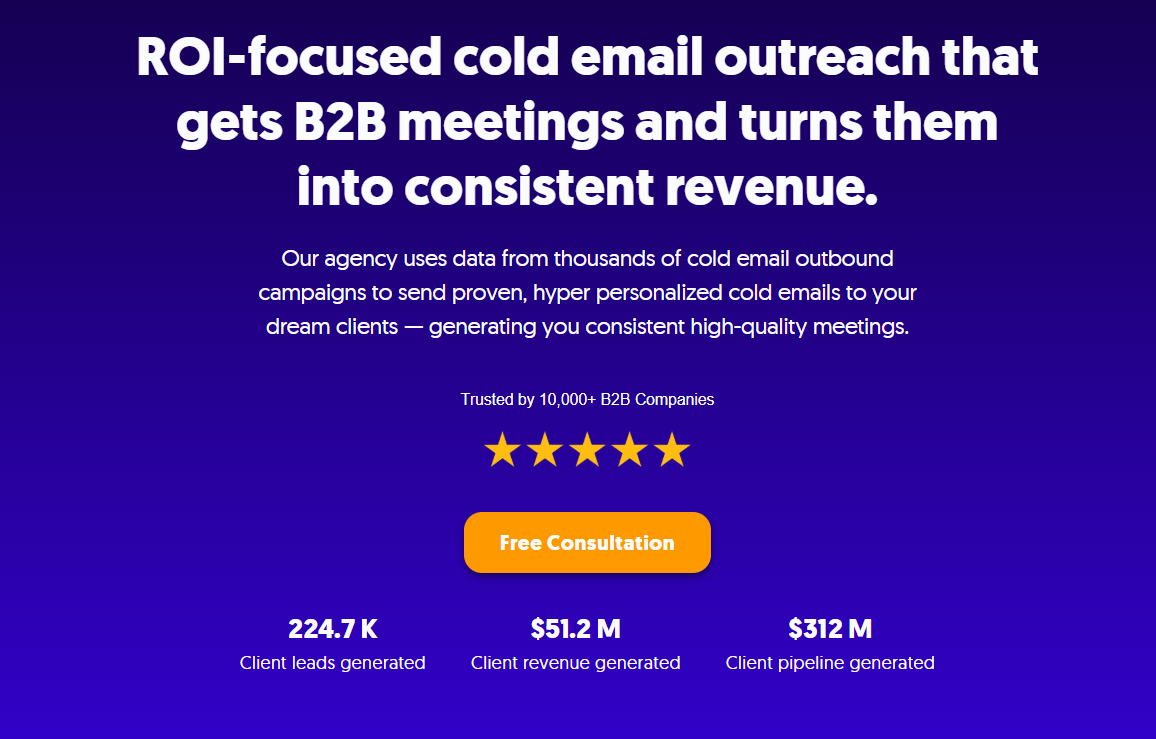
Here's how we're different:
🔥 You only pay for results. Our pricing model is simple: pay per meeting-ready lead. No retainers. No paying for "effort." You only pay when we send you a qualified prospect who's actually interested in talking. If we don't deliver leads, you don't pay. That's it.
🔥 We handle everything. List building, copywriting, technical setup, deliverability optimization, A/B testing, follow-up sequences—it's all done for you. You just show up to meetings with warm prospects who actually want to hear from you.
🔥 We've cracked the formula. After running millions of emails across every industry, we know what works. The messaging angles that get replies. The follow-up cadences that convert. The technical setup that keeps you out of spam. We've already made the mistakes so you don't have to.
🔥 It's a predictable pipeline. No hoping your ads perform. No waiting months for SEO. No praying your SDR gets lucky. With Cleverly, you get a consistent flow of qualified meetings every month. Plan your hiring. Forecast your revenue. Actually hit your targets.

If you're serious about scaling your outbound and want a b2b cold email agency that only gets paid when you get results, let's talk.
🚀 Book a call with Cleverly

Conclusion
B2b cold email isn't dead—it's just that most people are doing it wrong. Generic messaging, bad data, and broken technical setup kill campaigns before they start.
But when you nail the fundamentals—tight targeting, personalized messaging, solid deliverability, and relentless follow-ups—cold email becomes your most predictable client acquisition channel. No algorithm changes. No ad spend surprises. Just consistent pipeline.
Use the templates, tactics, and frameworks in this guide. Test what works for your audience. Optimize based on real metrics, not guesses.
And if you'd rather skip the trial and error and work with a team that's already generated hundreds of millions in pipeline for companies like yours? That's what we're here for.
Start building your outbound engine today. The clients you want are already in their inbox—you just need to show up the right way.
Frequently Asked Questions



